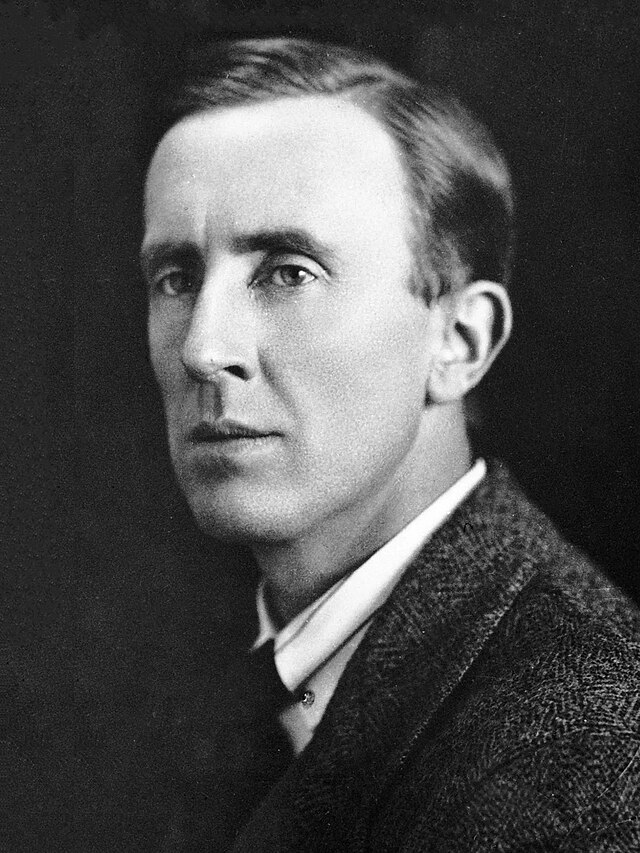J. R. R. Tolkien: Difference between revisions - Wikipedia
 Article Images
Article Images
Content deleted Content added
Line 12: | genre = [[High fantasy]], [[Translation]], [[Criticism]] | debut_works = ''[[The Hobbit]]'', 1937 | influences = [[George MacDonald]], [[ | influenced = [[C. S. Lewis]]; other later authors of [[high fantasy]] and [[fantasy]] in general | signature = Tolkien signature.svg Line 41: After being orphaned, Tolkien was brought up by Fr. Francis Xavier Morgan of the [[Birmingham Oratory]] in the [[Edgbaston]] area of Birmingham. He lived there in the shadow of [[Perrott's Folly]] and the [[Victorian architecture|Victorian]] tower of [[Edgbaston Waterworks]], which may have influenced the images of the dark towers within his works. Another strong influence was the [[Romanticism|romantic]] medievalist paintings of [[Edward Burne-Jones]] and the [[Pre-Raphaelite Brotherhood]]; the [[Birmingham Museum and Art Gallery]] has a large and world-renowned collection of works and had put it on free public display from around 1908. === In 1911, while they were at [[King Edward's School, Birmingham]], Tolkien and three friends, Rob Gilson, Geoffrey Smith and Christopher Wiseman, formed a semi-secret society which they called "the [[TCBS|T.C.B.S.]]", the initials standing for "Tea Club and Barrovian Society", alluding to their fondness for drinking [[tea]] in Barrow's Stores near the school and, illicitly, in the school library.<ref>{{ME-ref|Biography|pages 53 – 54}}</ref> After leaving school, the members stayed in touch, and in December 1914, they held a "Council" in London, at Wiseman's home. For Tolkien, the result of this meeting was a strong dedication to writing poetry. Line 49: Tolkien graduated from the [[University of Oxford]] (where he was a member of [[Exeter College, Oxford|Exeter College]]) with a first-class degree in [[English studies|English]] language in 1915. === Tolkien met and fell in love with [[Edith Bratt|Edith Mary Bratt]] at the age of sixteen, though she was three years older. Father Francis prohibited him from meeting, talking, or even corresponding with her until he was twenty-one. He obeyed this prohibition to the letter.<ref>{{cite web| last=Doughan|first=David| year=2002|url= http://www.tolkiensociety.org/tolkien/biography.html#2 | title=War, Lost Tales And Academia|work = J. R. R. Tolkien: A Biographical Sketch|accessdate = 2006-03-12}}</ref>, with one notable early exception which made Father Morgan threaten to cut short his University career if he did not stop.<ref>[[Humphrey Carpenter]]: [[J. R. R. Tolkien: A Biography]], George Allen & Unwin, 1977, page 43.</ref> On the evening of his twenty-first birthday, Tolkien wrote to Edith a declaration of his love and asked her to marry him. Edith replied saying that she had already agreed to marry another man, but that she had done so because she had believed Tolkien had forgotten her. The two met up and beneath a railway viaduct renewed their love; Edith returned her engagement ring and chose to marry Tolkien instead.<ref>{{ME-ref|Biography|pp. 67–69}}</ref> Following their engagement Edith converted to Catholicism at Tolkien's insistence.<ref>{{ME-ref|Biography|page 73}}</ref> They were engaged in Birmingham, in January 1913, and married in [[Warwick, England|Warwick]], [[England]], at Saint Mary Immaculate Catholic Church on [[22 March]] [[1916]].<ref>{{ME-ref|Biography|page 86}}</ref> === As the [[United Kingdom]] was then engaged in fighting [[World War I]], Tolkien enlisted in the [[British Army]] and served as a [[Second Lieutenant]] in the eleventh [[battalion]] of the [[Lancashire Fusiliers]].<ref>{{ME-ref|Biography|page 85}}</ref> His battalion was moved to France in 1916, where Tolkien served as a communications officer during the [[Battle of the Somme (1916)|Battle of the Somme]]. He came down with [[trench fever]] on [[27 October]] [[1916]] and was evacuated to England on [[8 November]] [[1916]].<ref>{{ME-ref|Biography|page 93}}</ref> Many of his dearest friends, including Gilson and Smith of the T.C.B.S., were killed in the war. In later years, Tolkien indignantly declared that those who searched his works for [[World War I]] parallels were entirely mistaken. <blockquote>"One has indeed personally to come under the shadow of war to feel fully its oppression; but as the years go by it seems now often forgotten that to be caught in youth by [[1914]] was no less hideous an experience than to be involved in [[1939]] and the following years. By [[1918]] all but one of my close friends were dead."<ref> "The Lord of the Rings," Preface to the Second Edition.</ref></blockquote> Tolkien's [[Webley Revolver|Webley .455]] service revolver is currently on display as part of a [[First World War]] exhibition in the [[Imperial War Museum]], [[London]].{{Fact|date=September 2007}} === During his recovery in a cottage in [[Great Haywood]], [[Staffordshire, England|Staffordshire]], [[England]], he began to work on what he called ''[[The Book of Lost Tales]]'', beginning with ''[[The Fall of Gondolin]]''. Throughout 1917 and 1918 his illness kept recurring, but he had recovered enough to do home service at various camps, and was promoted to lieutenant. | |||